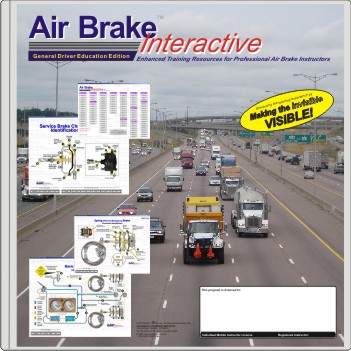
AIR BRAKE Interactive General Driver Education (GDE)
AIR BRAKE Interactive General Driver Education Edition (ABI-GDE) is an all-encompassing and easy-to-use educational tool for professional driver trainers, specifically designed to offer a detailed and engaging teaching experience for students learning about air brake systems in heavy vehicles. This resource covers the full spectrum of air brake knowledge, from the fundamentals of the system’s design and operation to the more intricate aspects of routine inspection, maintenance, and adjustments required for optimal performance.
With ABI-GDE, driver trainers can present a structured, consistent, and in-depth training program that ensures their students gain a thorough understanding of the essential elements of air brake systems. The interactive format and comprehensive visual aids make complex concepts more accessible and easier to grasp, promoting faster learning and better retention of critical information.
Students will not only gain theoretical knowledge but also practical insights into the real-world application of air brake systems. This enhanced understanding helps them recognize potential issues and troubleshoot effectively, leading to safer, more skilled drivers. By integrating ABI-GDE into your training program, you are investing in the success of your students, helping them to become more competent, confident, and safety-conscious drivers who can handle the operational challenges and responsibilities associated with modern heavy vehicle air brake systems.
What’s Included:
Sample Animations
Why Air Brake Training for Drivers?
A heavy vehicle’s air brakes are its single most important safety system. Although drivers in most jurisdictions are required to know something about the air brake systems employed on their vehicles, in many cases, the required curriculum is woefully inadequate. As a result many commercial vehicle drivers simply do not know enough about their vehicle’s air brakes to recognize when they are functioning properly and when they are not.
The following supports this position:
December 2008 – The American Association of Motor Vehicle Administrators
Because no driver training standards exist, many drivers are trained primarily to pass the State knowledge and skills tests. The Task Force believes a gap exists between the testing required by the CDL program and the knowledge and skills needed to safely operate a CMV.
February 2006 – NTSB Acting Chairman Mark V. Rosenker said, “We believe that more than 500,000 vehicles equipped with air brakes may be operated by drivers who have no air brake training and therefore may not be able to operate their vehicles safely. This situation needs to change – and change quickly.”
The Solution
The solution to inadequate driver knowledge regarding air brake systems is education – thorough education as opposed to just enough knowledge to acquire a CDL. Understanding air brake systems is not difficult, provided that instructors themselves have the knowledge required to properly teach the subject and are equipped with comprehensive and effective teaching resources. Our AIR BRAKE Interactive General Driver Edition teaching resource fits and fills that requirement like no other program available.
GDE Instructor’s Reference and Presentation Guide
The GDE Instructor’s Reference and Presentation Guide is a full-color resource designed to support instructors in delivering effective and engaging GDE presentations. This comprehensive guide spans 260 pages across 12 modules, providing instructors with the tools they need to ensure their training sessions are well-structured, informative, and impactful.
The guide serves as both a step-by-step presentation aid and a technical reference. It offers detailed instructions for each section of the GDE curriculum, allowing instructors to confidently navigate the content and deliver a cohesive learning experience from start to finish.
Included within the guide are practical tips for presentation delivery, strategies for keeping students engaged, and suggestions for interactive exercises that help reinforce key concepts. The guide also highlights specific components of the air brake system and related issues, offering in-depth explanations to ensure that instructors are equipped to address any questions or challenges that may arise during training.
Whether you’re new to teaching or an experienced instructor, the GDE Instructor’s Reference and Presentation Guide ensures that every class runs smoothly, helping you deliver a thorough and consistent message while also supporting student comprehension and retention of critical air brake system knowledge.
The Multimedia Presentation
The GDE multimedia presentation includes 44 voice-narrated air brake components and system animations and 80 additional high-quality support visuals. Ultimately, your students will see, hear, and remember how an entire modern air brake functions. It’s Visual Learning at its best!
For more information on each module, click on the “v”.
ABI-GDE Content

For more information and to discuss your specific needs, ideas, or questions with one of our expert teaching resource developers, we encourage you to reach out to us. Our team is dedicated to creating high-quality, engaging, and effective teaching materials tailored to your unique requirements. Please don’t hesitate to contact us via:
Bryan Duross
TECHNICAL TRAINING SERVICES
Telephone: 519-621-0708
E-Mail: bduross@sentex.net
For a FREE full-version demo, Contact Us!

General Driver Education
Available Formats
Traditional Install
Online Access
